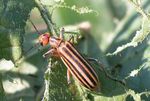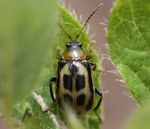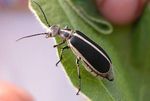COMMON DEFOLIATING BEETLES IN SOYBEAN - UT Crops
←
→
Page content transcription
If your browser does not render page correctly, please read the page content below
W 392
COMMON DEFOLIATING BEETLES
IN SOYBEAN
Scott Graham, Graduate Research Assistant
Scott Stewart, Professor
Department of Entomology and Plant Pathology
typically emerge from eggs in less than two weeks
JAPANESE BEETLE and then feed on grass roots. The larvae go through
three instars, becoming fully grown by nine weeks
Classification and Description after hatch. Full-grown, third instar white grubs tun-
nel down in the soil to overwinter. After winter, white
The Japanese beetle, Popillia japonica, is a scarab grubs crawl back up in the root zone to continue
beetle commonly found in Tennessee. This beetle feeding until they enter a prepupal stage for roughly
can be a pest of gardens, trees, shrubs, turfgrass 10 days. Adults emerge after an 8-20 day pupation
and agricultural fields. Adults have a bright metallic period, depending on weather conditions.
green head and thorax with copper-colored elytra
(hardened wings) and a row of five spots of white Pest Status and Injury
hairs on each side of the abdomen below the wings.
They are oval shaped and vary in length from 8 to 11 Japanese beetles primarily feed on the upper foli-
millimeters and a width of 5 to 7 millimeters. Larvae age of plants or on blooms, consuming leaf tissue
or “white grubs” are found in the soil and vary in col- between veins leaving a lace-like skeleton. Although
or from white to light gray and have a brown head. not a common problem, Japanese beetles may cause
Japanese beetle white grubs have three pairs of legs. significant defoliation of soybean in Tennessee.
The body is covered with short brown hair (setae)
and blunt brown spines. These white grubs lie in a
“C” shape when resting. Recently laid eggs are ellip-
soidal, measuring about 1.5 millimeters in diameter
and are shiny and milky white in color. Eggs become
more spherical in shape as they absorb water and
develop prior to hatching.
Hosts, Life History, Distribution
Japanese beetles are an invasive pest orginiating
from the Japanese archipelago. First discovered in
the United States in New Jersey in 1916, they now
can be found in most of the country east of the
Mississippi River. These polyphagous beetles feed on
a variety of plant hosts (300-plus) including fruits,
vegetables, ornamentals and agricultural crops.
Japanese beetles have one generation per year in
most climates. These beetles overwinter as third
instar grubs in the soil. Adults typically emerge from
late May through late July and tend to aggregate
and feed in clusters. Mating often occurs on the
foliage where they feed. Females burrow 2-5 inches
into the soil to lay eggs. A female Japanese beetle
can deposit up to 60 eggs in her lifespan. LarvaeBEAN LEAF BEETLE Classification and Description The bean leaf beetle, Cerotoma trifurcate, is a com- monly found chrysomelid beetle in soybean fields. Adults are about 6 millimeters in length and some- times have pairs of black spots on their wings. The color of bean leaf beetles varies, but they are usu- ally reddish, yellowish or tannish. A key identifying characteristic of bean leaf beetles is a black trian- gle on the top of the wings behind the base of the thorax. The small larvae are roughly 13 millimeters in length when fully grown and inhabit the soil. They have whitish bodies with a brown head and a brown posterior end and are sometimes confused with corn rootworm larvae. Eggs are orange in color and lemon shaped. They can typically be found in clusters in the soil near the base of soybean stems. Hosts, Life History, Distribution Bean leaf beetles feed on a variety of host plants including clover, corn, peanut and soybean. They typically have two or three generations per year in the Southeast. Adults overwinter in leaf litter. Upon emergence, new beetles move onto weedy hosts or cultivated plants. Bean leaf beetles migrate to soybean fields as soon as plants begin to emerge. First generation beetles feed on the leaves of seed- ling plants and lay eggs in the upper 2 inches of the soil. An adult female can lay up to 250 eggs in her lifetime. Depending on temperature, eggs hatch between 4 and 14 days. The larvae develop through three instars in roughly three weeks, and the pupal stage lasts about one week. Pest Status and Injury Adult bean leaf beetles typically damage soybean plants by chewing holes in leaves, but they occa- sionally feed on pods. Holes in leaves are roughly spherical in shape. Heavy feeding by first genera- tion bean leaf beetles on seedling plants can lead to stand loss in severe cases, but most economic damage is caused by defoliation of larger soybeans from later generations. Although damage is rarely economical, larvae can feed on roots and nodules of soybean plants. Bean leaf beetle is also a vector of bean pod mottle virus. Soybean plants infected with bean pod mottle virus can show a variety of symptoms from chlorotic leaf mottling, puckering and necrosis. This virus may also cause “green stem syndrome,” a disorder where the soybean stem stays green even after the plant has matured, making harvest more difficult. Although there is potential for economic loss from bean pod mottle virus, it is rarely a major concern in Tennessee. 2
Hosts, Life History, Distribution
MEXICAN BEAN BEETLE
Mexican bean beetle can be found on several host
Classification and Description plants, including legumes, cowpea and soybean.
The Mexican bean beetle, Epilachna varivestis, is Three to four gernerations can be produced each
an invasive beetle found in Tennessee. This insect is year in the Southeast. Adults overwinter in plant de-
interesting because it is a leaf-feeding beetle in the bris and wooded areas and do not emerge until early
family Coccinellidae, in which predaceous lady-bird spring. Upon emergence, females begin laying eggs
beetles or ladybugs are predominant. The preda- in clusters of 40-60 eggs on the underside of host
ceous species in this family are beneficial insects plant leaves. Larvae hatch in 5-12 days. The larvae
that feed on soft-bodied insects such as aphids. mature, pupate and emerge as adults about 32 days
Adult Mexican bean beetles measure 6-7 millimeters after hatching.
in length, are orange to copper colored, and shaped
Pest Status and Injury
like most ladybird beetles. These beetles have 16
black spots on their wing covers in a 6–6–4 pattern. Adult and larval Mexican bean beetles feed on the
Larvae are pale yellow to orange colored with six underside of soybean leaves between the leaf veins.
dorsal rows of branched longitudinal spines, causing In doing so, they leave a characteristic lacy appear-
them to look “fuzzy.” Eggs are oblong, oval, bright ance that is somewhat distinct from that caused by
yellow and laid in clusters on the bottom of leaves. Japanese beetles. This is because they may feed only
These eggs are roughly 1 millimeter in diameter and on the surface of leaves, leaving a window-paned
4 millimeters in length. effect. Only on rare occasions will Mexican bean
beetle populations reach levels high enough to cause
economic damage, and this primarily occurs in the
eastern and more northern counties of Tennessee.
Photographs courtesy of Ric Bessin, University of Kentucky Extension.
BLISTER BEETLES Hosts, Life History, Distribution
Classification and Description Blister beetles can be found on a variety of host
plants including tomoato, pepper, sweetpotato and
Blister beetles, Epicauta spp., are somewhat com- soybean. They also are commonly observed feeding
mon meloid beetles found on soybean in Tennessee. on Palmer amaranth. Most blister beetles have one
When disturbed, these beetles secrete cantharidin generation per year in Tennessee. They overwinter
from the joints of their legs. Cantharidin can cause as pseudopupae in the soil. Pupation occurs in the
burning and blistering of the skin, giving blister bee- spring when the soil temperature and moisture reach
tles their name. Adults are soft-bodied beetles. Their a threshold level, and the adult emerges about two
appearance varies based on species, but adults are weeks later. Females lay egg masses in clusters of
roughly 2 centimeters in length. The striped blister 50-300 eggs in the soil or under rocks. Eggs will typ-
beetle has alternating dark brown and yellow stripes ically hatch within two weeks. The larval stages are
along the length of the body. The margined blister predatory, feeding upon grasshopper eggs.
beetle is black with a gray border along the margins
of its wing covers. The prothorax of blister beetles, Pest Status and Injury
the area between the head and the wings, is narrow-
Adult blister beetles feed in clusters and skeltonize
er than the head and the wings. Larvae are grub-like
soybean leaves, often making large and irregular
and found in the soil.
3holes. Insecticide treatment for blister beetles is ized to a few small ares of the field, and oftentimes
seldom needed. Some soybean varieties are more blister beetles will leave a soybean field as quickly
preferred by blister beetles than others. When blis- as they arrived.
ter beetles are present, feeding is typically local-
MANAGEMENT CONSIDERATIONS AND Hadi, B. A., J. D. Bradshaw, M. E. Rice, and J. H. Hill.
THRESHOLDS 2012. Bean leaf beetle (Coleoptera: Chrysome-
lidae) and bean pod mottle virus in soybean:
Sweep-net sampling and visual scouting can be used biology, ecology, and management. Journal of
to determine which insects are causing defoliation in Integrated Pest Management, 3(1), B1-B7.
soybean fields, and this may include defoliating cat-
erpillars and other insects not described in this publi- Johnson, D. 2000. Bean leaf beetle in Kentucky soy-
cation. Treatment thresholds for defoliating beetles beans. University of Kentucky Extension, ENT-
are primarily basesd on percent defoliation and crop FACT-131, https://entomology.ca.uky.edu/ef131.
growth stage. It is common that multiple species are Kinney, K. K., F. B. Peairs, and A. M. Swinker. 2010.
contributing to defoliation. Soybean plants are most Blister beetles in forage crops. Colorado State
sensitive to defoliation during bloom and pod-fill- University Extension, Fact Sheet 5.524.
ing stages (R1-R6), and treatment is recommended
during this window if defoliation levels reach or ex- Mexican bean beetle. 2009. Purdue University,
ceed 20-25 percent. Currently recommended insec- https://extension.entm.purdue.edu/
ticides and thresholds can be found in UT Extension fieldcropsipm/insects/mexican-bean-
publication PB 1768, “Tennessee Insect Control Guide beetle.php.
Recommendations for Field Crops” (extension. Sanchez-Arroyo, H. 2015. Featured creatures: Mex-
tennessee.edu/publications/Documents/PB1768.pdf). ican bean beetle. University of Florida,
http://entnemdept.ufl.edu/creatures/veg/bean/
mexican_bean_beetle.htm.
SOURCES Townsend, L. H. 2011. Blister beetles. University of
Kentucky Extension, ENTFACT-102,
Bennet, K. and J. Hahn 2005. Bean leaf beetles in https://entomology.ca.uky.edu/ef102.
home gardens. University of Minnesota Exten-
sion, http://www.extension.umn.edu/garden/ Vera Krischik and D. Maser. Japanese beetle manage-
insects/find/bean-leaf-beetles. ment in Minnesota. University of Minnesota Ex-
tension, http://www.extension.umn.edu/
Cranshaw, W. 2011. Japanese beetle. Colorado State garden/insects/find/japanese-beetles.
University Extension, Fact Sheet 5.601.
W 392 01/17 17-0076
Programs in agriculture and natural resources, 4-H youth development, family and consumer sciences, and resource development. University of Tennessee Institute of Agriculture,
U.S. Department of Agriculture and county governments cooperating. UT Extension provides equal opportunities in programs and employment.You can also read

























































